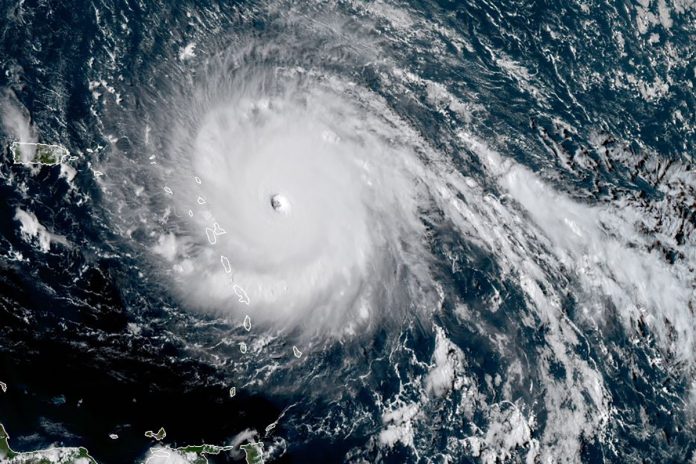
This could be The Big One, again, and everyone knows it, and if people here are getting a bit frantic, that might not be an irrational response. Hurricane Irma is about as big as a tropical cyclone can possibly get, and the latest computer models show it aimed at South Florida as if following directions by GPS.
There are more than 6 million people in Miami-Dade, Broward and Palm Beach counties, all concentrated between the beach and the swamps. Many have been streaming north on Interstate 95 or Florida’s Turnpike, and gas stations have plastic bags on the pumps. The region’s airports were slammed, and it had become difficult to score a seat on any airplane, going anywhere.
“I’m nervous, and I never get nervous in storms,” said Jane Llewellyn, a rental car sales agent at the Fort Lauderdale-Hollywood International Airport and a resident of Miami Beach. She said Irma seemed more “aggressive” than Andrew in 1992: “It’s just so massive and it’s just so fast, and it’s just so hot here. It’s going to get worse.”
Irma is an extremely dangerous Category 5 hurricane that had sustained winds of 185 mph as it ripped through the Caribbean on Wednesday, battering the northern Lesser Antilles and Virgin Islands, in some cases leaving behind massive destruction, such as on the small island of Barbuda. The storm next headed toward Puerto Rico, where some residents are preparing to be without electricity for as long as six months. Although the storm’s center passed north of Puerto Rico itself, the hurricane still delivered lashing rain bands, damaging winds and warnings of flash flooding.
On Wednesday, Irma hit Barbuda in the Leeward Islands, territories and commonwealths stretching southeast from Puerto Rico. A weather station recorded sustained winds of 118 mph and a wind gust to 155 mph before the instrument failed, according to the National Hurricane Center, which called the storm’s conditions “life-threatening.”
This hurricane’s 185-mph maximum sustained winds are the strongest recorded for a landfalling hurricane in the Atlantic Ocean, tied with the 1935 Florida Keys hurricane.
The National Hurricane Center said on Wednesday evening that Irma remains powerful and that Puerto Rico should expect hurricane conditions through Wednesday night and could see as much as 20 inches of rain in some places. The storm is projected to pass by the Dominican Republic, Haiti and Cuba in the next two days before it could make landfall somewhere in South Florida on Sunday, though intense winds could begin long before that.
In San Juan, Puerto Rico, people in the Hato Rey neighborhood prepared for the storm under unusually calm, cool weather Wednesday that gave way to a light drizzle. People expect to lose power, which is nothing unusual for the neighborhood, where power often goes out for a few hours after a heavy rainstorm.
The power went out at about 10:15 a.m. on Wednesday. Even though her house was boarded up, Rita Hernandez could hear the singsong calls of “Yucca! Platanos!” from a pregonero – a roaming fruit and vegetable vendor – making what was likely his last run before the storm truly arrived.
With the storm still days away, it was relatively unusual for the people of South Florida to go into full-on storm preparation mode. But this is a scary hurricane at a moment when anyone paying attention to the news understands what a big storm can do.
On Virginia Key, at the University of Miami’s Rosenstiel School of Marine and Atmospheric Science, professor David Nolan was putting heavy plastic over computer terminals, in case the roof leaks during the storm. He said his family plans to drive to Atlanta, while he’ll ride it out behind storm shutters at his home in Coral Gables. But that plan could change, he said. Lots of people are still thinking this through.
The mood in South Florida, he said, “is frantic.”
“Anxious, frantic,” chimed in his colleague, senior research associate Brian McNoldy.
“I saw a gas-station-induced car accident happen right in front of me yesterday,” Nolan said.
McNoldy, who contributes to The Washington Post’s Capital Weather Gang, called up the model forecasts and showed how Irma is expected to move in more or less a straight line toward Florida, west by northwest, but then hang a sharp right to the north. That track could send it right to McNoldy’s cubicle and on up the Gold Coast, as if the storm were trying to grind away a century of urbanization.
“That’s extremely bad,” he said. “That’s basically every East Coast Florida city. This could easily be the most expensive U.S. storm if this happens.”
He hastened to add, as all forecasters do, that a forecast four or five days in advance is typically off by something like 185 miles, and Irma could still veer west toward the Gulf or stay east and never make landfall.
But it could also go right up the center of the peninsula.
“We’re surrounded by hot water,” McNoldy said. “The state itself is not good at doing damage to hurricanes. It’s flat. It’s pretty wet, so you’re not going to drag in dry air. They don’t weaken much.”
The Florida Keys are particularly vulnerable. Monroe County, home to the Keys, began mandatory evacuations of tourists and visitors Wednesday morning. The county’s 80,000 residents were ordered to evacuate beginning Wednesday evening.
The main drag in Key West, Duval Street, was largely empty Wednesday. Many storefronts already had been sandbagged and boarded up. But some people will ride out the storm – as Floridians often do even when told they’re supposed to leave.
At the Ernest Hemingway Home and Museum, general manager Jacqui Sands said she’s not going anywhere. She is charged with securing the legendary author’s 19th-century estate as well as ensuring the safety of the 55 cats that roam the lush grounds here, many of them with six and seven toes on each paw.
“If I didn’t have to, I wouldn’t stay,” Sands said. “My kids told me to get the hell out. But I have an obligation to take care of the building and the cats.”
The petite 72-year-old will be joined by nine employees, four of whom she has sent off to retrieve storm shutters and plywood from a nearby storage facility to board up windows and doors. “They couldn’t leave because either they don’t have a car or couldn’t find a flight out of here,” she said. “I think we are going to be fine.”
At the Key West Port, the cruise ships had long departed for safer docks, and the inlet was devoid of pleasure craft. Only four small vessels remained in the marina, including a 50-foot boat that ferries residents and hotel guests to and from Sunset Key, a private, 27-acre resort located in waters nearby.
The ship’s captain, William “Harry” Privette, 80, said he’s never been caught in a hurricane.
“Every time, it either veered off or never arrived,” he said. He hopes to keep his track record intact. “I know what happens when they show up. I don’t want to be here when this one does. It’s nasty.”
Late Tuesday evening, some mainstays, including Sloppy Joe’s, kept the doors open for dozens of straggling tourists. R.E.M.’s “It’s the End of the World as We Know It” blared through the speaker system.
Broward County Mayor Barbara Sharief said mandatory evacuations would begin Thursday at noon for people in the eastern portion of the county that runs alongside the Atlantic Ocean.
“This storm is bigger, faster and stronger than Hurricane Andrew,” Florida Gov. Rick Scott (R) said Wednesday, emphasizing that even with Irma’s uncertain trajectory, officials were preparing for a direct impact. “Do not sit and wait for the storm to come. It is extremely dangerous and deadly and will cause devastation. Get prepared right now.”
Scott, who earlier this week declared a statewide emergency, has warned that Irma could require large-scale evacuations and severely impact areas battered last year by Hurricane Matthew, which sent punishing flooding into parts of the state.
Officials across Florida responded to the dire forecasts by slowly shutting down the contours of daily life. Schools closed; the NFL postponed the Miami Dolphins’ season opener scheduled for Sunday; the University of Central Florida in Orlando, which could face punishing weather if Irma crawls up the coastline, moved a football game to Friday night; and the University of Miami – the Hurricanes – announced the cancellations of its football game set for this Saturday in Arkansas so the team doesn’t have to travel.
Storm preparations also were underway at two nuclear sites in Florida – 45-year-old Turkey Point 25 miles south of Miami and 41-year-old St. Lucie further north along the coast. They belong to NextEra, a utility with about 5 million electricity customers in Florida. NextEra said that it will shut down its four nuclear reactors before Irma makes landfall. That will reduce the heat in the reactors and the need for electricity.
NextEra also said that its reactors could weather a loss of electricity of the sort that caused a meltdown at Japan’s Fukushima Daiichi reactors after the tsunami there in 2011. NextEra spokesman Peter Robbins said that the nuclear plants have diesel generators located 20 feet above sea level inside reinforced concrete structures.
People across Florida who planned to ride out the storm were clearing store shelves of water, food and supplies, and people trying to drive north had to search for gas – and hotel rooms. Many streamed to South Florida’s airports.
At the Fort Lauderdale airport, Sandy Lukaszewicz of Deerfield Beach, Florida, showed the text she’d sent Tuesday morning to her brother-in-law in Indiana: “I’m scared but I don’t want boog to know it. She’s gonna witness mother nature’s most powerful ocean churn.”
“Boog” is her sister Karen Romanski, who had been visiting. They saw Hurricane Irma reach Category 5 intensity and early Tuesday decided to evacuate, going online to nab four tickets to Chicago on Southwest Airlines. They were evacuating their mother, Virginia Gay, 87, and her friend Thelma Leonard, 91, who sat patiently in wheelchairs Wednesday near the Southwest ticket counter.
“I’ve been through Wilma. I’ve been through Andrew. I saw what’s coming,” said Lukaszewicz, 56. She said she noticed the storm forming off the coast of Africa a week or so ago and thought to herself, “That looks like Andrew.”
“I wish I could stay home,” said Gay, her mother. But her daughters had been emphatic, telling her, according to Lukaszewicz: “You have no choice. We made a family decision. We’re going.”
The airport had been jammed since before dawn with people trying to get out of the state. Florida’s peninsular geography makes flight the best way to flee an oncoming hurricane, but there are only so many planes to catch.
By early Wednesday morning, it was hard to get a seat on a plane going anywhere. Seats that were available still for purchase at Florida airports were often exorbitantly expensive, in the range of $2,000.
Some of those who were leaving said modern technology, and modern communications, helped inform their decisions – and made them easier.
“Back in the 1800s, people wouldn’t have had a warning,” said Renee Gray, flying with her husband Mitch to their home in Nashville, Tennessee, after evacuating from Islamorada, in the Florida Keys, at 4 a.m. “Today we’ve got warnings, and we have to take advantage of that.”
(c) 2017, The Washington Post · Joel Achenbach, Francisco Alvarado, Sandhya Somashekhar, Mark Berman
{Matzav.com}












If the corrupt airlines are charging $2000 dollars for a one way ticket, WHY AREN’T THEY ARRESTED FOR PRICE GOUGING??? Why are they above the law? Why is our corrupt government going to bail them out again when they declare bankruptcy???